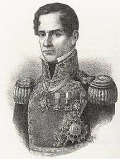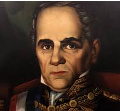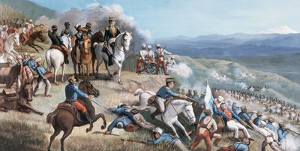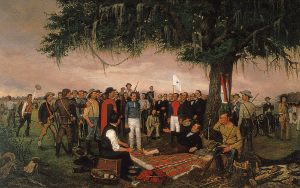Antonio Lopez de Santa Anna: Mexican General, President
Antonio Lopez de Santa Anna was a Mexican war hero and president who enjoyed great success and great failure, on the battlefield and in politics. He remains one of Mexico's most famous military leaders. He was born on Feb. 21, 1794 in Xalapa, Veracruz, and had a slight formal education. What he really wanted to be was a soldier, and so he did that, joining the Army of New Spain when he was 16. 
Talented and charismatic, he advanced to the rank of lieutenant at 18 and had a rapid rise up through the military ranks, reaching the rank of captain in 1816. After a group of rebels declared an independence movement in 1810, Santa Anna fought first with the army, in defense of the constitutional monarchy, but later with the rebellion, in the final stages of the revolution. He was at turns friend and foe of the first few leaders of the new country of Mexico. Agustín de Iturbide, who led the group of Spanish soldiers who also switched sides and sealed the demise of the Spanish government in Mexico, was the new country's first new emperor and rewarded Santa Anna for his allegiance with a position Victoria served out his four-year term as president and was succeeded by Manuel Gómez Pedraza. Santa Anna was so incensed with Pedraza's victory that he called for the election results to be thrown out and set about organizing yet another rebellion. He found enough support militarily and politically to force Pedraza to leave the country; and rebel hero Vicente Guerrero, who had received the second-highest vote total in the election and who had been Santa Anna's choice, assumed the presidency. Spain had thoughts of reconquering Mexico in the late 1820s and invaded in 1829. Santa Anna took up arms in defense of his country and led the Mexican forces to victory. Spanish forces had invaded Tampico, and Santa Anna's victory there led to his being referred to as the "Victor of Tampico." He styled himself the "Napoleon of the West" and sought (in vain) to imitate the great French emperor's success in battle and governance. Four years later, he was elected President, the first of 12 times that he held the office. (Not all of those were full terms following an election.) He became president after yet another disputed election, followed by the elected Vice-president's leading an armed rebellion against Guerrero. Santa Anna's election in 1833 was seen by many as a plea for stability. He was a national hero who appealed to a great many people. He accepted the role but found it less than stimulating. Not long after being elected, he retirned to Veracruz, handing over most of the responsibilities of governing to Vice-president Dr. Valentín Gómez Farías. The latter's promotion of liberal reforms led many Mexican conservatives to question Santa Anna's judgment. The president responded in 1834 by invalidating Farías's reforms, dissolving the Congress, and forming a new government with himself as dictator. The response was sharp and swift from several Mexican states, who took the radical step of declaring a rebellion of their own and forming their own governments. One of these rebellious states was Coahuila y Tejas, the northern part of which would become the Republic of Texas. Santa Anna led his military against the rebel states and brought them all back into the fold except Texas. Santa Anna is perhaps most well-known to students of American history because he was in charge of the country and/or the army for most of the 1830s and 1840s, when the following events happened:
After the war, Santa Anna left the country, taking up exile in Jamaica and then living for a time in Colombia. Yet another rebellion in 1853 resulted in yet another call for Santa Anna to come back and lead the country. He did so and was elected president in that year. One well-known set of events that occurred during this period in American and Mexican history was the Gadsden Purchase, which completed the borders of the contiguous American states. Santa Anna married twice, both to teenage girls from wealthy families. Oddly, he appeared at neither wedding, deputizing first the bride's father and then oen of his friends to stand in during the ceremony. He and his first wife had four children; they were the only children he had. 
One of the things that Santa Anna struggled with for most of his life was an affinity for gambling. This preference for taking big chances with money rarely resulted in his winning it big. One thing he did succeed at was selling chicle to manufacturers in the U.S. Santa Anna envisioned it as something to be used in tires but couldn't convince any wheelmakers in the U.S. to use it as such. An inventor and entrepreneur named Thomas Adams refined the substance, adding flavorings and sweeteners to it, and founded a chewing gum company. He was ousted from office for the last time in 1855 and spent most of the last two decades of his life in exile, living in Colombia, Cuba, and the U.S. and on the island of St. Thomas. Offered amnesty in 1874, he accepted and returned. He died, nearly blind, at age 80 on June 21, 1876, in Mexico City. Santa Anna has a mixed reputation. Many during his own time and later on revered him as a hero, particularly for his role in overthrowing the Spanish monarchy. However, he is also remembered for losing a large amount of Mexican territory to the U.S. and for styling himself a despot on multiple occasions.
|
|
Social Studies for Kids
copyright 2002–2025
David White



 as the leader of Veracruz, a vibrant and strategic port city on the Gulf of Mexico. Friction between the two men led to Iturbide's removing Santa Anna from the post, and the latter rose up in revolt. Joining Santa Anna were a pair of other rebel leaders, Nicolás Bravo and Vicente Guerrero, who had also at one time fought with Iturbide. The resulting coalition succeeding in overthrowing Iturbide and, through a blueprint known as the Plan of Casa Mata, established a representative government. Iturbide left in 1823, the Mexican Constitution came a year later, and Guadalupe Victoria was the new republic's first president.
as the leader of Veracruz, a vibrant and strategic port city on the Gulf of Mexico. Friction between the two men led to Iturbide's removing Santa Anna from the post, and the latter rose up in revolt. Joining Santa Anna were a pair of other rebel leaders, Nicolás Bravo and Vicente Guerrero, who had also at one time fought with Iturbide. The resulting coalition succeeding in overthrowing Iturbide and, through a blueprint known as the Plan of Casa Mata, established a representative government. Iturbide left in 1823, the Mexican Constitution came a year later, and Guadalupe Victoria was the new republic's first president. A group of Texians declared themselves independent from Mexico in 1836.
A group of Texians declared themselves independent from Mexico in 1836.
